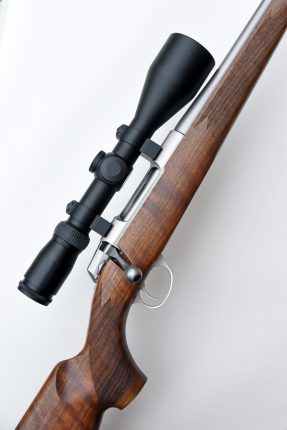Despite its modernity, this smart bolt-action rifle from the well-respected Finnish gunmaker remains pleasingly old school, says Michael Yardley
Sako 90 Hunter Stainless .308 review
This month’s test spotlights a Sako 90 Hunter Stainless bolt-action rifle imported by GMK. The 90 was launched last year in a range of styles (seven are listed by GMK) and calibre options from .22-250 to .300 Winchester Magnum in various action lengths. Our test gun is stainless steel .308 with a conventional wooden stock incorporating a slightly stepped Monte-Carlo comb and restrained cheekpiece (Sako also offers carbon-fibre and fibreglass stock options). It weighs in at 7¼lb without telescopic sight, so around 81/2lb to 9lb ‘on the hill’ with a medium-sized scope fitted.

First impressions are good. It is a clean-looking, modern design retaining classical form and shapes, with a wellsized grip that has a slight right-hand palm swell (left-handed 90s are available). The relatively slender forestock is well proportioned and the mid-profile 221/2in barrel free floats within it. All the action furniture, the barrel and the action are satin-finished stainless steel. The magazine is a staggered design with five-shot capacity. Usefully, it can be loaded from the top while still in place (the top of the receiver has been opened up to facilitate this). As in the 85, the magazine must be depressed slightly against spring pressure before the release catch can be activated. The bolt shroud has a sprung plunger on the face that meets the receiver – a new feature – and the bolt will only rotate with this pushed in, which prevents accidental de-cocking or disassembly when the bolt is removed.
Dispensing with Sako’s old tapered scope grooves, the 90 provides a straight 17mm dovetail on top of the receiver with recoil stud recesses (copied from the Tikka T3x). Some 90s have the option of a split Picatinny rail: a military-inspired addition becoming popular with rifle enthusiasts because it allows for easy change of optical systems. There is also a new method of trigger-pull adjustment on all 90s: five preset detent clicks correspond to weights from just under 2lb to just under 4lb. These are set using a torque key inserted through the triggerguard to engage a controlling wheel forward of the trigger. Previously, adjustment of trigger-pull on the 85 was quite complicated; now it is easily done by any user. The single-stage trigger is exceptionally crisp too, and the smooth-faced aluminium trigger-blade may be adjusted for position. Lock time is just 1.3ms.
To understand the new 90 properly, one needs to consider its predecessors. In 1996, Sako’s 75th-anniversary year, the Sako 75 was introduced. Widely considered to be ‘bombproof’, it gave rise to both the 85 and new 90, which are largely based upon it. The 75 featured a push-feed action with a three-lug bolt, allowing for reduced bolt lift and particularly strong lock-up. It standardised a detachable magazine in the Sako range. The 85 followed 10 years later in 2006, which retained the strong three-lug bolt, modified the magazine to avoid accidental release (it had to be pressed down before activating the catch, as noted) and introduced a new controlled-round cartridge feed system. The last, in more complex form, was a notable feature of the Mauser model 1898.
In the 98, a large claw extractor on the bolt captures the cartridge rim as the bolt is moved forward, controlling the round as it goes into the chamber. Push feeds dispensing with this were later popularised by makers such as Remington and 1964-1992-era Winchester because they offered simplified production. The extractor on the 85 was smaller than the classic Mauser type but it still captured the cartridge rim, controlling it as it progressed to the chamber (so the 85, unlike the 90, is properly called controlled feed). Mauser-type controlled feed became much favoured by some rifle aficionados, especially hunters of dangerous game. It is now absent in many reliable and accurate modern designs, though debate about the system continues in online forums.

TECHNICAL
Like the 75 and 85, the Sako 90 is based on a much-developed push feed with triple locking lugs. Contact/locking areas on the bolt are slightly increased in the new gun. As well as the new trigger mechanism already discussed, it introduces a modified bolt head with double ejector plungers taken from the latest TRG sniper rifles. The 85 (like the 75) had a spring-loaded blade ejector in the receiver, which had the potential disadvantage of pushing the round up as the action is opened, possibly causing a malfunction if the case hits the scope or the top of the action and falls back towards the magazine. The new design throws the cartridge case out sideways more decisively, thanks to the double plungers. The 90 also uses modified rifling twist rates to suit non-toxic ammunition: 1:10 will become the standard Sako rate in .308, from 1:11 in the 85.
SHOOTING IMPRESSIONS
I have shot many Sakos, including the geared lever-action Finnwolf: a great design worth revisiting. This 90 feels solid. It’s no lightweight, although several lighter 90s are available. The gun handles intuitively with good balance. Stock shapes, comb height and stock length (14in) are all well chosen. The slimmish rounded fore-stock, grip and chequering all please. A fairly compact action lessens bolt travel. The bolt handle itself is quite short but has a good-sized, comfortable knob. Reduced length minimises torque effects when cycling but brings the hand close to the rear of the scope. The safety is positive and quiet, and the trigger is superb. With 1 MOA (minute of angle) guaranteed, the 90 is also reassuringly accurate. It is an excellent, evolved rifle. Better than the 85? Yes.




